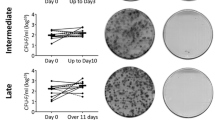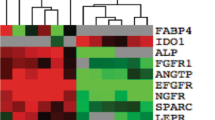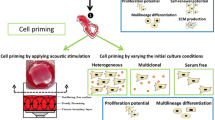Abstract
Mesenchymal stem cells (MSCs) participate in regenerative osteogenesis by generating bone-forming cells. To examine the proliferative capacity of MSC populations from bone marrow and their relationship to trauma severity (multiple trauma, monofracture, atrophic nonunion), we quantified colony properties of human MSCs in vitro. Serum levels of mediators associated with bone formation were also assessed. Fifty-five individuals were enrolled in this study (13 multiple trauma patients, 15 patients with monofracture, 20 patients with atrophic nonunions, 7 healthy volunteers). The colony forming unit-fibroblast (CFU-F) assay was used to quantify total colony number, mean cell density per colony, and mean colony area. MSC phenotype was established using flow cytometry and osteogenic differentiation. MSCs obtained from multiple-trauma patients yielded the highest reservoir. Significant differences in colony numbers of MSCs in female subjects were found between multiple-trauma patients (mean ± SD 48 ± 21 CFU-F/culture) and healthy volunteers (18.7 ± 3.3 CFU-F/culture, P < 0.05), patients with monotrauma (15 ± 10 CFU-F/culture, P < 0.05), and patients with atrophic nonunions (6.3 ± 4.1 CFU-F/culture, P < 0.05). In male participants, significant differences were found between patients with nonunions (14 ± 14 CFU-F/culture) and healthy volunteers (54 ± 17 CFU-F/culture, P < 0.05) as well as multiple-trauma patients (59 ± 25 CFU-F/culture, P < 0.05). The highest proliferative capacity (cell density) was seen in multiple-trauma patients. These data suggest that trauma severity and gender affect the reservoir and proliferation capacity of bone marrow-derived MSCs.




Similar content being viewed by others
References
Buckwalter JA, Glimcher MJ, Cooper RR, Recker R (1996) Bone biology, part II. Formation, modelling, remodelling and regulation of cell function. Instr Course Lect 45:371–386
Friedenstein AJ, Petrakova KV, Kurolesova AL, Frolova GP (1968) Heterotopic transplants of bone marrow. Analysis of precursor cells for osteogenic and hematopoietic tissues. Transplantation 6:230–247
Pittenger MF, Mackay AM, Beck SC, Jaiswal RK, Douglas R, Mosca JD, Moorman MA, Simonetti DW, Craig S, Marshak DR (1999) Multilineage potential of adult human mesenchymal stem cells. Science 284:143–147
Bruder SP, Fink DJ, Caplan AI (1994) Mesenchymal stem cells in bone development, bone repair, and skeletal regeneration therapy. J Cell Biochem 56:283–294
Horch RE, Bannasch H, Kopp J, Andree C, Stark GB (1998) Single-cell suspensions of cultured human keratinocytes in fibrin glue reconstitute the epidermis. Cell Transplant 7:309–317
Long MW, Robinson JA, Ashcraft EA, Mann KG (1995) Regulation of human bone marrow derived osteoprogenitor cells by osteogenic growth factors. J Clin Invest 95:881–887
Quarto R, Thomas D, Liang D (1995) Bone progenitor cell deficits and the age-associated decline in bone repair capacity. Calcif Tissue Int 56:123–129
Friedenstein AJ, Chailakhjan RK, Lalykina KS (1970) The development of fibroblast colonies in monolayer cultures of guinea-pig bone marrow and spleen cells. Cell Tissue Kinet 3:393–403
Clarke E, McCann SR (1989) Age dependent in vitro stromal growth. Bone Marrow Transplant 4:596–597
Bruder SP, Jaiswal N, Haynesworth SE (1997) Growth kinetics, self renewal, and the osteogenic potential of purified human mesenchymal stem cells during extensive subcultivation and following cryopreservation. J Cell Biochem 64:278–294
Jaiswal N, Haynesworth SE, Caplan AI, Bruder SP (1997) Osteogenic differentiation of purified, culture-expanded, human mesenchymal stem cells in vitro. J Cell Biochem 64:295–312
Muschler GF, Nitto H, Boehm CA, Easley KA (2001) Age- and gender-related changes in the cellularity of human bone marrow and the prevalence of osteoblastic progenitors. J Orthop Res 19:117–125
Stenderup K, Justesen J, Eriksen EF, Rattan SI, Kassem M (2001) Number and proliferative capacity of osteogenic stem cells are maintained during aging and in patients with osteoporosis. J Bone Miner Res 16:1120–1129
Justesen J, Stenderup K, Eriksen EF, Kassem M (2002) Maintenance of osteoblastic and adipocytic differentiation potential with age and osteoporosis in human marrow stromal cell cultures. Calcif Tissue Int 71:36–44
Muschler GF, Boehm C, Easley K (1997) Aspiration to obtain osteoblast progenitor cells from human bone marrow: the influence of aspiration volume. J Bone Joint Surg Am 79:1699–1709
Lin E, Calvano SE, Lowry SF (2000) Inflammatory cytokines and cell response in surgery. Surgery 127:117–126
Wildburger R, Zarkovic N, Tonkovic G, Skoric T, Frech S, Hartleb M, Loncaric I, Zarkovic K (1998) Post-traumatic hormonal disturbances: prolactin as a link between head injury and enhanced osteogenesis. J Endocrinol Invest 21:78–86
Strecker W, Gebhard F, Rager J, Brückner UB, Steinbach G, Kinzl L (1999) Early biochemical characterization of soft-tissue trauma and fracture trauma. J Trauma 47:358–364
Baker SP, O’Neill B, Haddon W Jr, Long WB (1974) The injury severity score: a method for describing patients with multiple injuries and evaluating emergency care. J Trauma 14:187–196
Greenspan L, McLellan BA, Greig RN (1985) Abbreviated injury scale and injury severity score: a scoring chart. J Trauma 25:60–64
Mareschi K, Ferrero I, Rustichelli D, Aschero S, Gammaitoni L, Aglietta M, Madon E, Fagioli F (2006) Expansion of mesenchymal stem cells isolated from pediatric and adult donor bone marrow. J Cell Biochem 97:744–754
Bergman RJ, Gazit D, Kahn AJ, Gruber H, McDougall S, Hahn TJ (1996) Age-related changes in osteogenic stem cells in mice. J Bone Miner Res 11:568–577
Majors AK, Boehm CA, Nitto H, Midura RJ, Muschler GF (1997) Characterization of human bone marrow stromal cells with respect to osteoblastic differentiation. J Orthop Res 15:546–557
Oreffo RO, Bennett A, Carr AJ, Triffitt JT (1998) Patients with primary osteoarthritis show no change with aging in the number of osteogenic precursors. Scand J Rheumatol 27:415–424
Oreffo RO, Bord S, Triffitt JT (1998) Skeletal progenitor cells and ageing human populations. Clin Sci (Lond) 94:549–555
Nishida S, Endo N, Yamagiwa H, Tanizawa T, Takahashi HE (1999) Number of osteoprogenitor cells in human bone marrow markedly decreases after skeletal maturation. J Bone Miner Metab 17:171–177
D’Ippolito G, Schiller PC, Ricordi C, Roos BA, Howard GA (1999) Age-related osteogenic potential of mesenchymal stromal stem cells from human vertebral bone marrow. J Bone Miner Res 14:1115–1122
Henrich D, Hahn P, Wahl M, Wilhelm K, Dernbach E, Dimmeler St, Marzi I (2004) Serum derived from multiple trauma patients promotes the differentiation of endothelial progenitor cells in vitro: possible role of transforming growth factor-ß1 and vascular endothelial growth factor165. Shock 21:13–16
Doucet C, Ernou I, Zhang Y, Llense R, Begot L, Holy X, Lataillade JJ (2005) Platelet lysates promote mesenchymal stem cell expansion: a safety substitute for animal serum in cell-based therapy applications. J Cell Physiol 205:228–236
Clark MA, Hentzen BT, Plank LD, Hill GI (1996) Sequential changes in insulin-like growth factor 1, plasma proteins, and total body protein in severe sepsis and multiple injury. JPEN J Parenter Enteral Nutr 20:363–370
Henrich D, Seebach C, Wilhelm K, Marzi I (2006) High dosage of simvastatin reduces TNF-α induced apoptosis of endothelial progenitor cells but fails to prevent apoptosis induced by IL-1β in vitro. J Sur Res (in press)
Ogueta S, Munoz J, Obregon E, Delgado-Baeza E, Garcia-Ruiz JP (2002) Prolactin is a component of the human synovial liquid and modulates the growth and chondrogenic differentiation of bone marrow-derived mesenchymal stem cells. Mol Cell Endocrinol 25:51–63
Roufosse CA, Direkze NC, Otto WR, Wright NA (2004) Circulating mesenchymal stem cells. Int J Biochem Cell Biol 36:585–597
Sethe S, Scutt A, Stolzing A (2005) Aging of mesenchymal stem cells. Ageing Res Rev 5:91–116
Brockstedt H, Kassem M, Eriksen EF, Mosekilde L, Melsen F (1993) Age- and sex-related changes in iliac cortical bone mass and remodeling. Bone 14:681–691
Kragstrup J, Melsen F, Mosekilde L (1983) Thickness of bone formed at remodeling sites in normal human iliac trabecular bone: variations with age and sex. Metab Bone Dis Relat Res 5:17–21
Abdallah BM, Haack-Sorensen M, Fink T, Kassem M (2006) Inhibition of osteoblast differentiation but not adipocyte differentiation of mesenchymal stem cells by sera obtained from aged females. Bone 39:181–188
Author information
Authors and Affiliations
Corresponding author
Rights and permissions
About this article
Cite this article
Seebach, C., Henrich, D., Tewksbury, R. et al. Number and Proliferative Capacity of Human Mesenchymal Stem Cells Are Modulated Positively in Multiple Trauma Patients and Negatively in Atrophic Nonunions. Calcif Tissue Int 80, 294–300 (2007). https://doi.org/10.1007/s00223-007-9020-6
Received:
Accepted:
Published:
Issue Date:
DOI: https://doi.org/10.1007/s00223-007-9020-6




